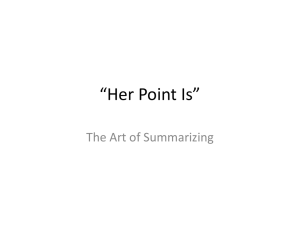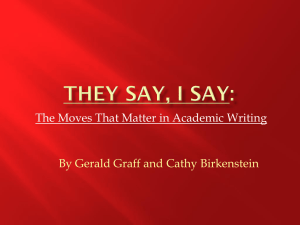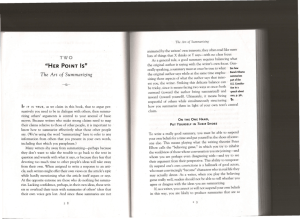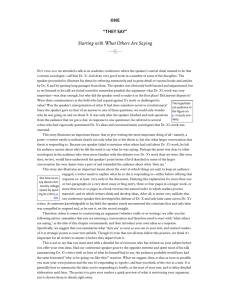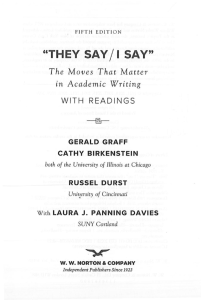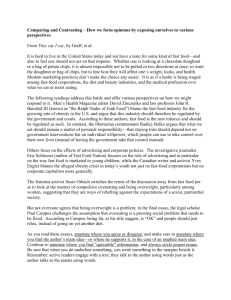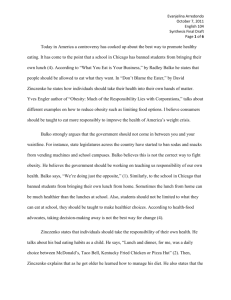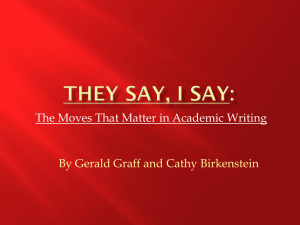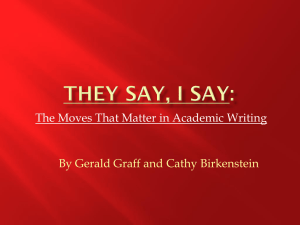They Say/I Say: Effective Summarizing Techniques
advertisement
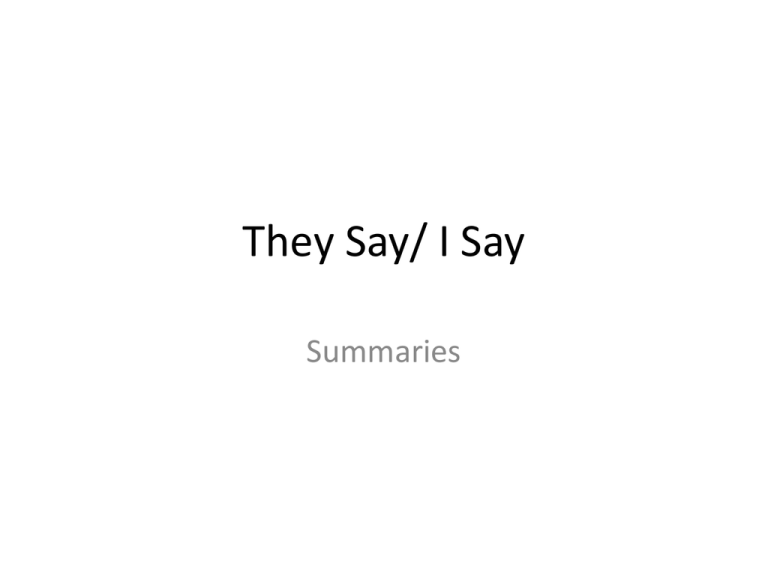
They Say/ I Say Summaries Practice 1. Read the Zinczenko article and write a summary indicating you disagree with the argument. 2. Read the Zinczenko article and write a summary indicating you agree with the argument. EXAMPLE • If you cannot suspend your beliefs you are likely to produce the following: • In his article “Don’t Blame the Eater,” David Zinczenko accuses the fast-food companies of an evil conspiracy to make people fat. I disagree because these companies have to make money. UNFAIR • The above summary is an unfair distortion of Zinczenko’s main point. • While Z. does argue that the practices of the fast-food industry have the effect of making people fat, he never goes so far as to suggest that the fast-food industry conspires to do so with deliberately evil intent. • The writer’s summary reveals his response quickly by cutting the summary very short. You must give your readers enough of the writer’s argument so the reader can assess its merits independently. CLICHÉ • A common mistake is to use cliché to summarize instead of actually responding to the text. • Study what others say very closely, so you do not collapse it to something you already have heard or know. Writers who fail to do this end up essentially conversing with themselves instead of the wider academic audience. OPINION • While you must “walk in the shoes” of the writer, you need not abandon or ignore your views altogether. While you must fairly represent the writer’s ideas, you may exert a quiet influence. • A GOOD SUMMARY HAS A FOCUS OR SPIN THAT ALLOWS THE SUMMARY TO FIT WITH YOUR OWN OVERALL AGENDA WHILE STILL BEING TRUE TO THE TEXT YOUR ARE SUMMARIZING. What to do? • Zinczenko’s article references three different points; parenting, corporate regulation, or warning labels. You’ll need to subordinate these three issues to Zinczenko’s general claim and then make sure this general claim directly sets up your own argument. Example • Read Summary on Hand Out • This summary succeeds not only because it provides one big claim under which several of Zinczenko’s points neatly fit, but also because this big claim points toward the second paragraph; the writer’s own thesis about parental responsibility. A lesser summary would merely include Zinczenko’s indictment of the fast-food industry and ignor what he says about parents. • • • In his article “Don’t Blame the Eater,” David Zinczenko argues that today’s fast-food chains fill the nutritional void in children’s lives left by their overtaxes working parents. With many parents working long hours and unable to supervise what their children eat, Zinczenko claims, children today regularly turn to low-cost, calorie-laden foods that the fast-food chains are all to eager to supply. When he himself was a young boy, for instance, and his single mother was away at work on a regular basis, he ate at Taco Bell, McDonald’s, and other chains on a regular basis, and ended up overweight. Zinczenko’s hope is that with the new spate of lawsuits against the food industry, other children with working parents will have healthier choices available to them, and that they will not, like him, become obese. In my view, however, it is the parents, and not the food chains, who are responsible for their children’s obesity. While it is true that many of today’s parents work long hours, there are still several things that parents can do to guarantee that their children eat healthy foods . . . (ideas would follow) This summary succeeds not only because it provides one big claim under which several of Zinczenko’s points neatly fit, but also because this big claim points toward the second paragraph; the writer’s own thesis about parental responsibility. A lesser summary would merely include Zinczenko’s indictment of the fast-food industry and ignor what he says about parents. A Mistake • Writer’s who summarize without regard to their own interests fall prey to what might be called “list summaries,” summaries that simply inventory the original author’s various points but fail to focus those points around any larger overall claim. • The author says many different things about his subject. First he says. Then he makes the point that… in addition he says… and then he writes … also he shows that… and then he says… HINT • WRITING A GOOD SUMMARY MEANS NOT JUST REPRESENTING AN AUTHOR’S VIEW ACCURATELY, BUT DO SO IN A WAY THAT FITS YOUR OWN COMPOSITION’S LARGER AGENDA. A SUMMARY MUST HAVE A SLANT OR SPIN THAT PREPARES THE WAY FOR YOUR OWN CLAIMS. It should reflect both the source and yourself. WORDS • Zinczenko doesn’t just say or believe—but complains or protests; he challenges, chastises and indicts those companies—USE VIVID AND PRECISE SIGNAL VERBS AS OFTEN AS POSSIBLE. YOUR TEXT WILL BE MORE ACCURATE AND MORE LIVELY IF YOU TAILOR YOUR VERBS TO SUIT THE PRECISE ACTIONS YOUR’RE DESCRIBING. Source • They Say / I Say Chapter 2 • by Gerald Graff and Cathy Birkenstein
